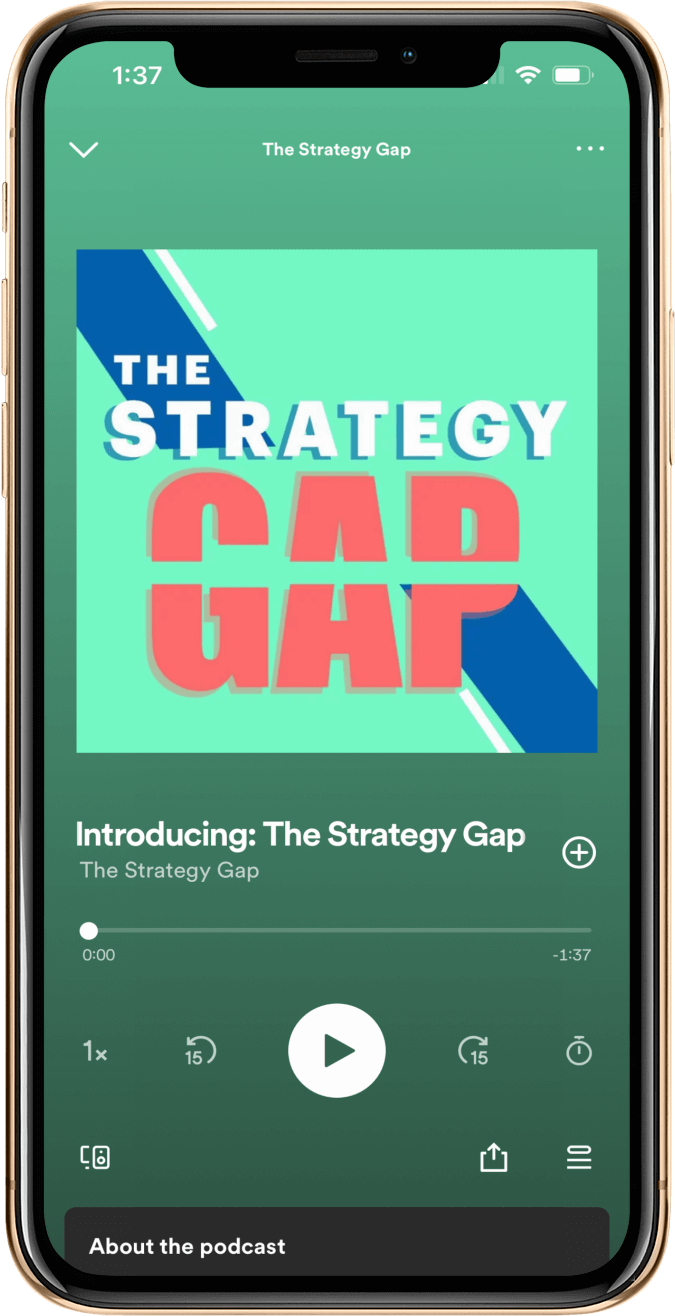When it comes to strategic planning, integrating your brand is not merely an option but a necessity. As Cheryl Farr pointed out in today’s epidode of The Strategy Gap podcast, “Brand is a leadership exercise. It’s not about marketing. It’s not about your color. It’s not about your logo. It’s about how you lead inside your organization and how you live that brand out.”
This perspective helps to reframe your brand as the cornerstone of your strategic approach rather than an afterthought or a set of superficial design elements.
But how do you make this transition from a marketing-centric view of brand to one that deeply embeds it within your strategic planning? Here, we unpack the insights from expert Cheryl Farr, Founder and Chief Strategist at SIGNAL Brand Innovation.
Listen to The Strategy Gap
A podcast about the space between savvy strategy and practical execution, including everything that can go wrong on the way.

1. Brand Integration in Strategic Planning
The first and most crucial step is to incorporate brand filters into your strategic planning. Joe Krause highlighted that a strategic plan shouldn’t just be a collection of great ideas, because thst can become overwhelming, especially with talented people involved. Joe says, “Let’s have a real honest discussion about what we’re doing and why we’re doing it. And anything we put in the plan that detracts from that, especially if you’re an established company, needs to really be scrutinized.”
Your brand should act as a guiding tool, helping you define achievable future visions and the specific commitments you’re making. By directly integrating brand elements into your strategic planning, you create a seamless alignment between business goals, operational realities, and brand commitments. This comprehensive approach ensures that your brand is more than just a visual or communicative aspect; it becomes a foundational principle that influences every part of your organization.
2. Articulating True, Meaningful, and Different Commitment
A key part of brand integration is clearly defining what makes your brand unique—its meaningful differences. Cheryl noted, “If Southwest Airlines really stays focused on what makes them different, they risk undermining that uniqueness.” Once you pinpoint these aspects and commit to them, they become powerful guides for all major strategic decisions.
Ask yourself: What does our brand uniquely offer? What commitments resonate with our audience? This filtering process ensures that every strategic move strengthens and builds on your brand’s core strengths, making it resilient and coherent for all stakeholders.
3. Building Customer Brand Loyalty
Creating and nurturing customer brand loyalty is a cornerstone of maintaining a strong and vibrant brand. According to Cheryl, “Customer loyalty is not just about repeat business; it’s about consistent alignment between what you promise and what you deliver.” Developing this loyalty involves more than just great products or services—it requires a deeply ingrained commitment to your brand’s promises at every customer touchpoint.
Building customer brand loyalty requires a strategic approach where every team member understands and lives out the brand’s principles. Cheryl emphasizes, “When your employees believe in your brand’s purpose and mission, it translates into genuine customer interactions that build trust and loyalty.” Therefore, nurturing an internal culture that reflects your brand values is just as crucial as your external marketing efforts.
4. Brand Evolution and Storytelling
Change is inevitable in any organization, but how these changes are communicated can determine their success. Farr highlighted a crucial step that organizations often overlook: “Using brand filters to tell this story to our customers in a way that will make it feel like a natural evolution, not a disconnect.”
When strategic changes feel abrupt or inconsistent with your brand’s promises, they can cause confusion or dissatisfaction among customers. By leveraging your brand filters, you can craft narratives that present these changes as positive, natural progressions. This not only preserves customer trust but also strengthens the brand’s relationship with its audience.
5. Brand as Leadership
Perhaps the most transformative insight from Cheryl Farr was her assertion that “brand is fundamentally about leadership within the organization.” This brings an invaluable leadership perspective into the concept of brand. It’s about how leaders within the organization embody and advocate for the brand’s values and mission.
This internal living out of the brand translates into a more authentic and powerful external brand presence. When leaders within the organization exemplify the brand, it becomes evident in every interaction, decision, and communication, leading to a more holistic and convincing brand experience for customers and employees alike.
6. Advice for Strategy Practitioners
Towards the end of the podcast, when asked what advice she would give to her younger self, Cheryl Farr didn’t hesitate: “Make it crystal clear to your clients that brand is a leadership exercise.” This advice is invaluable for current and aspiring strategists. By ensuring clients understand that brand is integral to leadership, it strengthens the foundation of strategic initiatives and shapes your overall organizational behavior.
To sum up, integrating brand into your strategic planning isn’t just beneficial—it’s essential. From embedding brand filters and articulating meaningful differences to making deliberate strategic choices, every step should be approached with a brand-first mentality.
As Cheryl Farr eloquently put it, brand is about leadership—it’s a reflection of how you lead, make decisions, and ultimately, how you bring your organization’s values to life. By adopting these practices, you not only elevate your strategic planning but ensure that your brand remains a vibrant and guiding force within your organization.




